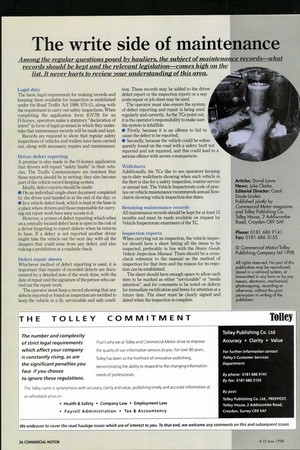The write side of maintenance Among the regular questions posed
Page 38

If you've noticed an error in this article please click here to report it so we can fix it.
by hauliers, the subject of maintenance records—what records should be kept and the relevant legislation—comes high on the list. It never hurts to review your understanding of this area.
Legal duty The basic legal requirement for making records and keeping them available for inspection is established under the Road Traffic Act 1988, 874 (1), along with the requirement to carry out safety inspections. When completing the application form (GV79) for an 0-licence, operators make a statutory "declaration of intent" (a form of legal promise) in which they undertake that maintenance records will be made and kept.
Records are required to show that regular safety inspections of vehicles and trailers have been carried out, along with necessary repairs and maintenance.
Driver defect reporting A promise is also made in the 0-licence application that drivers will report "safety faults" in their vehicles. The Traffic Commissioners are insistent that these reports should be in writing: they also become part of the vehicle record-keeping system.
Ideally, defect reports should be made: • On an individual single-sheet document completed by the driver and handed in at the end of the day; or • In a vehicle defect book, which is kept at the base in a place where drivers and those responsible for carrying out repair work have easy access to it.
However, a system of defect reporting which relies on a centrally located defect book is open to the risk of a driver forgetting to report defects when he returns to base. If a defect is not reported another driver might take the vehicle out the next day with all the dangers that could arise from any defect, and also risking a prohibition at a roadside check.
Defect repair sheets Whichever method of defect reporting is used, it is important that repairs of recorded defects are documented by a detailed note of the work done, with the date of repair and the signature of the person who carried out the repair work.
The operator must keep a record showing that any defects reported or found on inspection are rectified to keep the vehicle in a fit, serviceable and safe condi tion. These records may be added to the driver defect report or the inspection report; or a separate repair or job sheet may be used.
The operator must also ensure the system of defect reporting and repair is being used regularly and correctly. As the TCs point out, it is the operator's responsibility to make sure the system is infallible: • Firstly, because it is an offence to fail to cause the defect to be reported; • Secondly, because the vehicle could be subsequently found on the road with a safety fault not reported and not repaired, and this could lead to a serious offence with severe consequences.
Wallcharts Additionally, the TCs like to see operators keeping up-to-date walkharts showing when each vehicle in the fleet is due for a safety inspection, routine service or annual test. The Vehicle Inspectorate code of practice on vehicle maintenance recommends annual flowcharts showing vehicle inspection-due dates.
Retaining maintenance records All maintenance records should be kept for at least 15 months and must be made available on request by Vehicle Inspectorate examiners of the TC.
Inspection reports When carrying out an inspection, the vehicle inspector should have a sheet listing all the items to be inspected, preferably in line with the Heavy Goods Vehicle Inspection Manual. There should be a crosscheck reference to the manual so the method of inspection for that item and the reason for its rejection can be established.
The sheet should have enough space to allow each item to be marked as either "serviceable" or "needs attention", and for comments to be noted on defects for immediate rectification and items for attention at a future date. The sheet must be clearly signed and dated when the inspection is complete. Articles: David Lowe.
News: Julie Clarke.
Editorial Director: Carol Doyle-Linden. Published jointly by Commercial Motor magazine and Tolley Publishing Co, Tolley House, 2 Addiscombe Road, Croydon CR9 5AF.
Phone: 0181 6869141. Fax: 0181 6863155.
© Commercial Motor/Tolley Publishing Company Ltd 1998 All rights reserved. No part of this publication may be reproduced, stored in a retrieval system, or transmitted in any form or by any means, electronic, mechanical, photocopying, recording or otherwise, without the prior permission in writing of the publishers.




















































































































